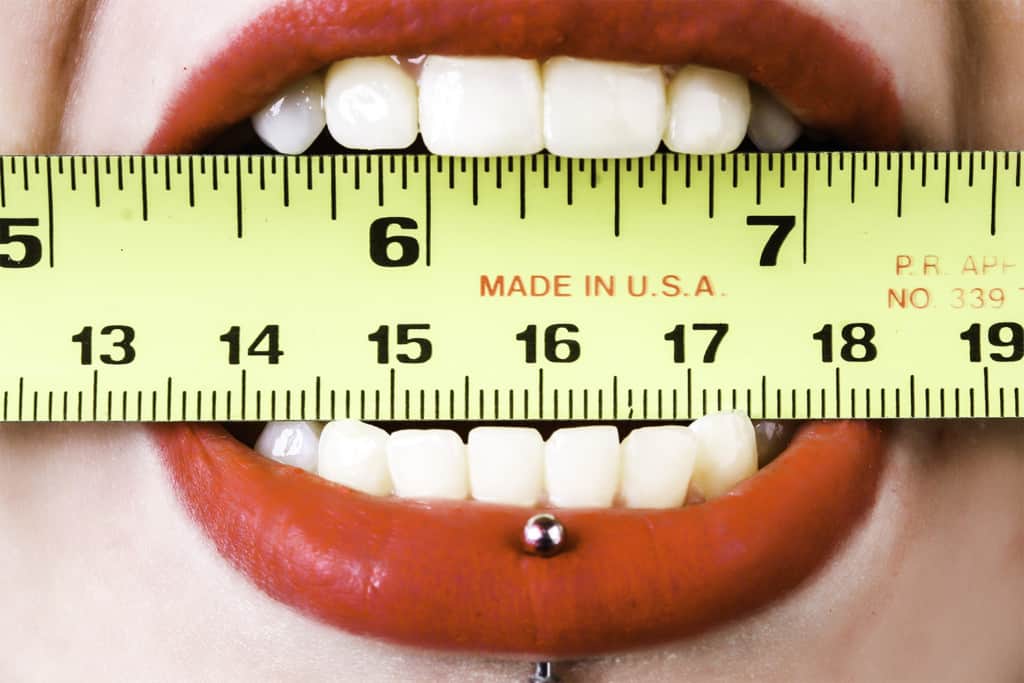
Ever hear your dental professional speaking in what sounds like code and you ask yourself “what the heck are they talking about?!”
Well if you want to crack the code, keep reading so you can follow along at your next dental appointment.
The numbering systems are also called dental notations and there are 4 main ones;
- FDI
- Universal
- Palmer, (including Palmer alternates; Haderup and Zsigmondy)
- Letter/Number
Different countries use different ways of numbering teeth so be sure to check the chart below for your country and the respective tooth numbering system used.
Below you can find a table I put together of a few countries and their dental notation used. Some countries I could not find information on so they are not included.
| Country | Dental Notation Most Used |
| Canada | FDI |
| The United States of America | Universal |
| United Kingdom | Palmer and FDI |
| Australia | FDI |
| Argentina | FDI |
| Barbados | Palmer |
| Brazil | FDI |
| Chile | FDI |
| China | Palmer |
| Colombia | FDI |
| Croatia | FDI, Palmer |
| Denmark | Haderup (Palmer alternate system) |
| France | FDI and Palmer |
| Germany | FDI |
| Greece | FDI |
| Hungary | Palmer |
| India | FDI and Zsigmondy (Palmer alternate system) |
| Indonesia | FDI |
| Isreal | FDI |
| Italy | FDI |
| Japan | Palmer |
| Jordan | Palmer |
| Libya | Palmer |
| Malaysia | FDI |
| Mexico | FDI and Universal |
| New Zealand | FDI |
| Norway | FDI |
| Pakistan | FDI and Universal |
| Peru | FDI |
| Poland | FDI |
| Russia | Palmer |
| Saudi Arabia | FDI |
| South Africa | FDI |
| Sri Lanka | Palmer |
| Sudan | Palmer |
| Sweden | FDI |
| Syria | Palmer |
| Thailand | Palmer |
| Turkey | FDI |
| Uganda | Palmer |
| United Arab Emirates | FDI |
| Venezuela | FDI |
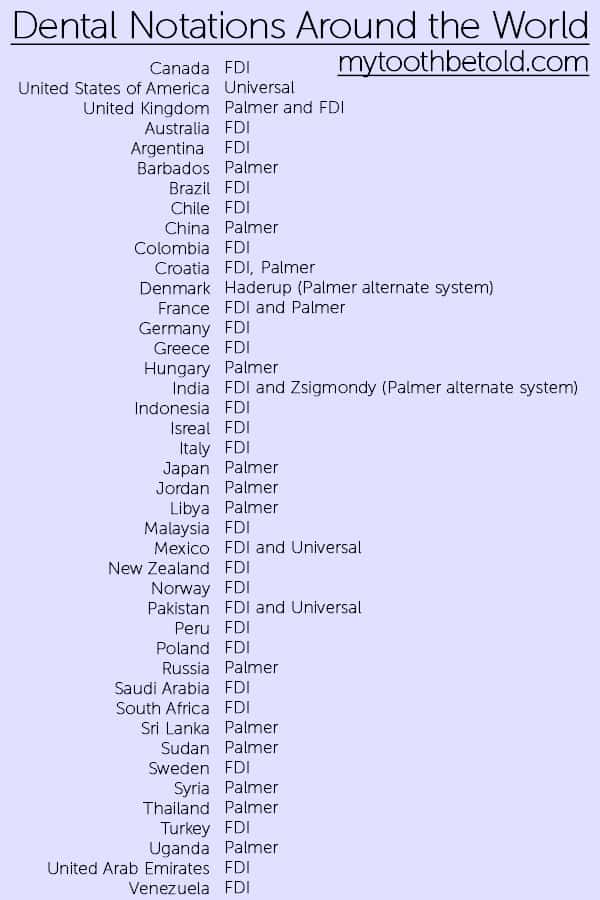
FDI, Universal, Palmer (including alternates), and Letter/Number notations
FDI (Federation Dentaire Internationale)
Out of all the ways to number teeth in the human jaw, the FDI system is by far the most widely used around the world.
The system uses 2 numbers to identify each tooth. The 2 numbers are separated by a period.
For example; #.#
The first number indicates what quadrant the tooth is in, with the mouth being divided into 4 quadrants.
Adult/Permanent Teeth
Quadrant Numbers;
| Location in Mouth | Quadrant # |
| Upper Right | 1 |
| Upper Left | 2 |
| Lower Left | 3 |
| Lower Right | 4 |
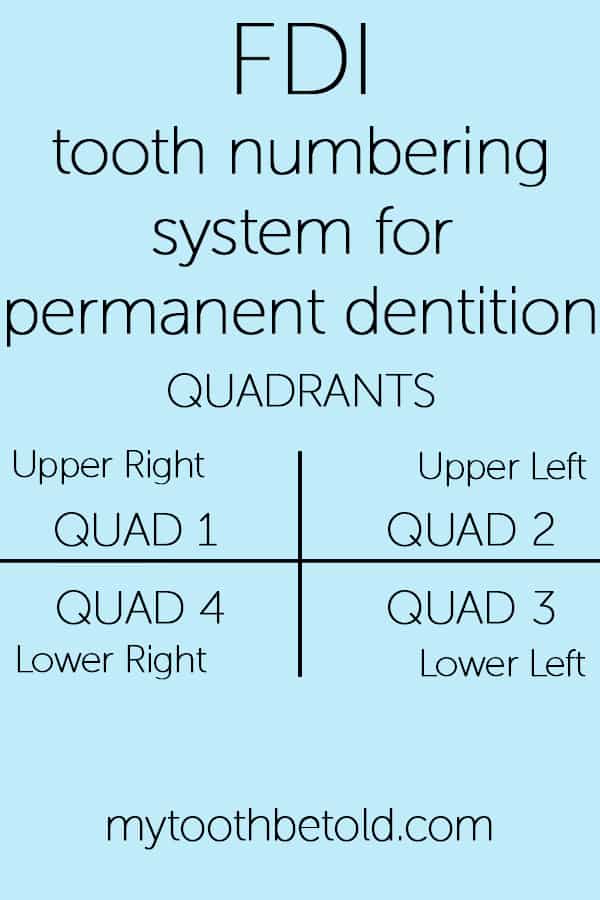
The second number indicates the location of the tooth WITHIN that quadrant.
The numbers of the teeth begin at the front of your mouth at the midline with the central incisors being 1 counting all the way up to 8 for the wisdom teeth.
Tooth Numbers WITHIN the quadrant;
| Tooth | Tooth # |
| Central Incisor | 1 |
| Lateral Incisor | 2 |
| Canine | 3 |
| 1st Premolar (1st bicuspid) | 4 |
| 2nd Premolar (2nd bicuspid) | 5 |
| 1st Molar (6-year molar) | 6 |
| 2nd Molar (12-year molar) | 7 |
| 3rd Molar (wisdom tooth) | 8 |
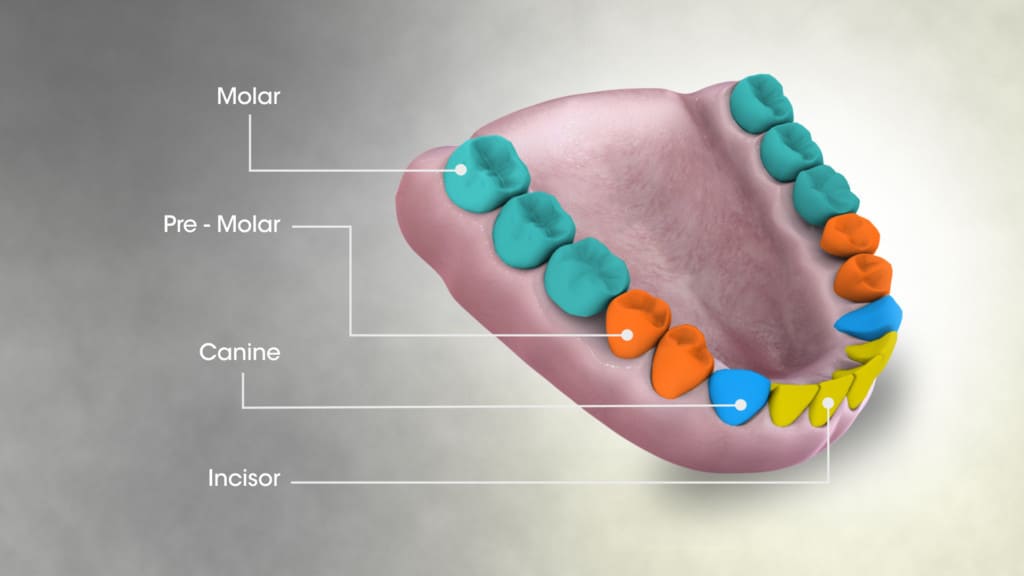
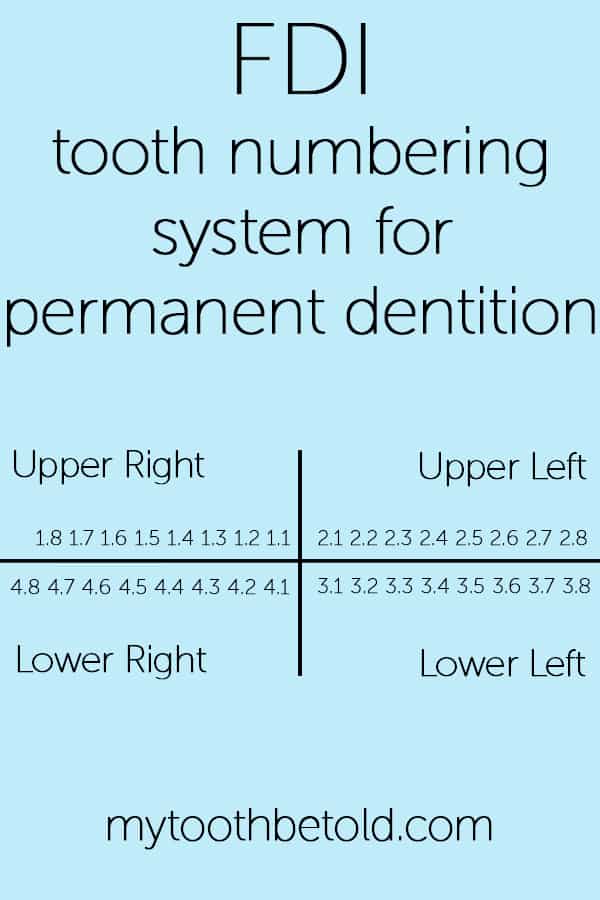
So when identifying a permanent tooth using the FDI notation system, the quad number comes first, then a period, then the tooth number. For example, the permanent upper right central incisor would be 1.1.
Baby/Primary (deciduous teeth)
The same principals go for the quadrants in the primary dentition however, they have different numbers.
Quadrant Numbers;
| Location in Mouth | Quadrant # |
| Upper Right | 5 |
| Upper Left | 6 |
| Lower Left | 7 |
| Lower Right | 8 |
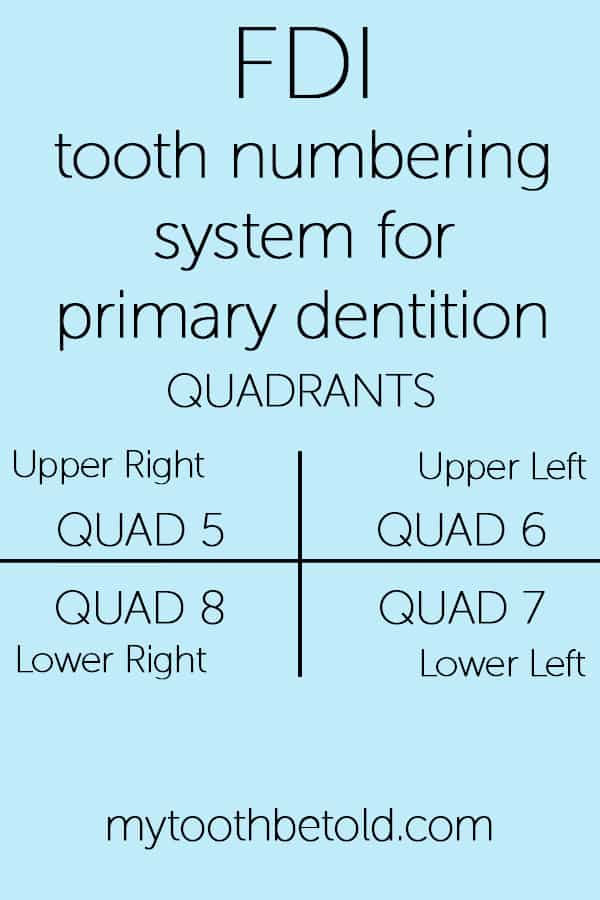
Tooth Numbers WITHIN the quadrant;
| Tooth | Tooth # |
| Central Incisor | 1 |
| Lateral Incisor | 2 |
| Canine | 3 |
| 1st Molar | 4 |
| 2nd Molar | 5 |
So the primary upper right central incisor would be 5.1 using the FDI numbering system.
Remember; there are no premolars in the primary dentition.
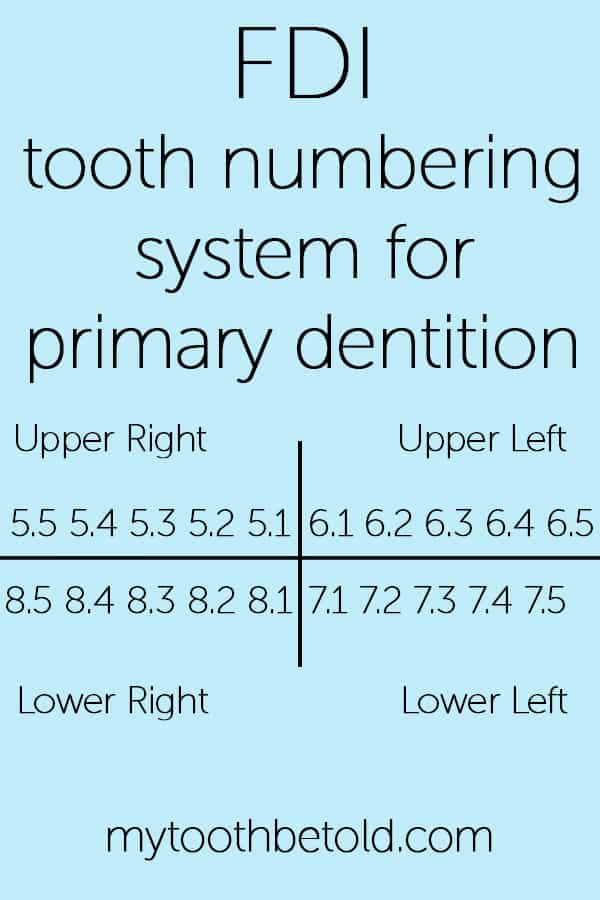
Read Now: the BEST dental products that should be in your bathroom NOW
Universal
Also known as the “American System”, this system foregoes the quadrants and just has a separate number for each tooth. The teeth are numbered from 1-32.
Starting on the upper right wisdom tooth which is number 1, the numbers continue to count upwards to the upper left wisdom tooth which is number 16.
The sequence then continues from the lower left wisdom tooth which is number 17 and extends around to the lower right wisdom tooth which is number 32.
Adult/Permanent Teeth
| Upper Right | Upper Left |
| 1,2,3,4,5,6,7,8 | 9,10,11,12,13,14,15,16 |
| 32,31,30,29,28,27,26,25 | 24,23,22,21,20,19,18,17 |
| Lower Right | Lower Left |
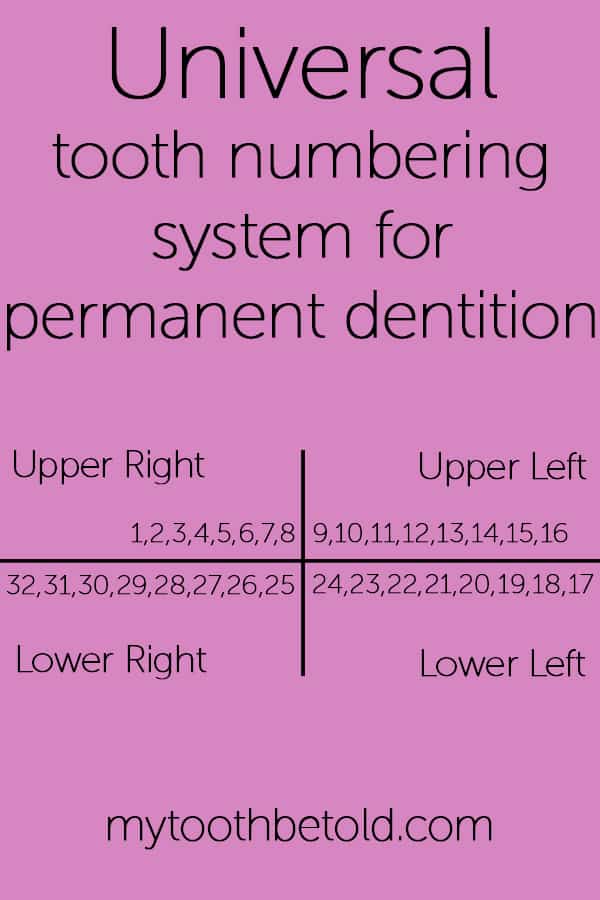
Baby/Primary (deciduous teeth)
The primary teeth don’t use numbers, rather they have letters that represent each tooth.
The same concept is used here as the adult dentition, starting on the upper right 2nd molar with the letter A, extending to the upper left 2nd molar which is J.
On the bottom, it continues on the lower left 2nd molar which is K, extending around to the lower right 2nd molar which is T.
| Upper Right | Upper Left |
| A,B,C,D,E | F,G,H,I,J |
| T,S,R,Q,P | O,N,M,L,K |
| Lower Right | Lower Left |
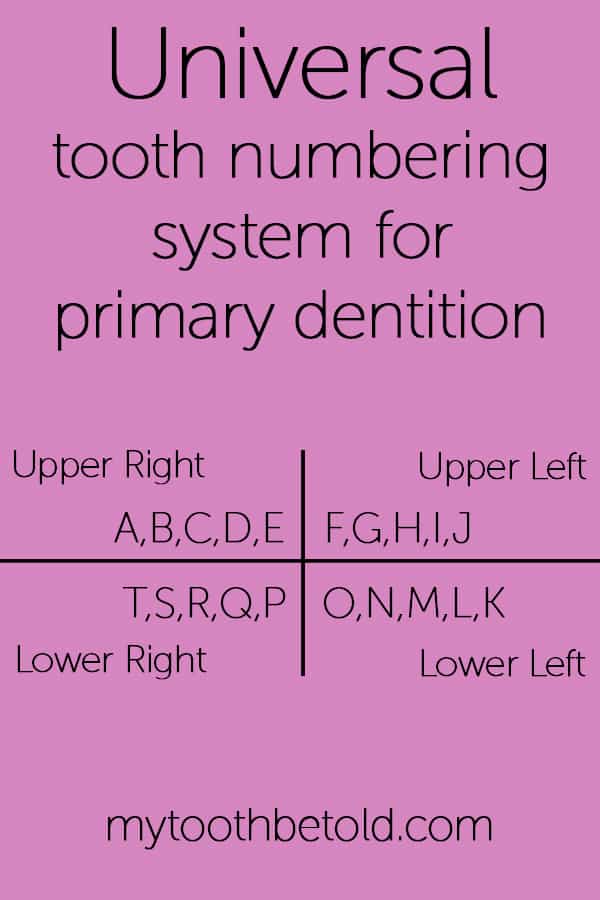
Baby/Primary (deciduous teeth) alternate system
This alternate system follows the numbering system of the adult teeth, however, a “d” is used following the number which stands for “deciduous” another term for baby/primary teeth.
| Upper Right | Upper Left |
| 1d, 2d, 3d, 4d, 5d | 6d,7d,8d,9d,10d |
| 20d,19d,18d,17d,16d | 15d,14d,13d,12d,11d |
| Lower Right | Lower Left |
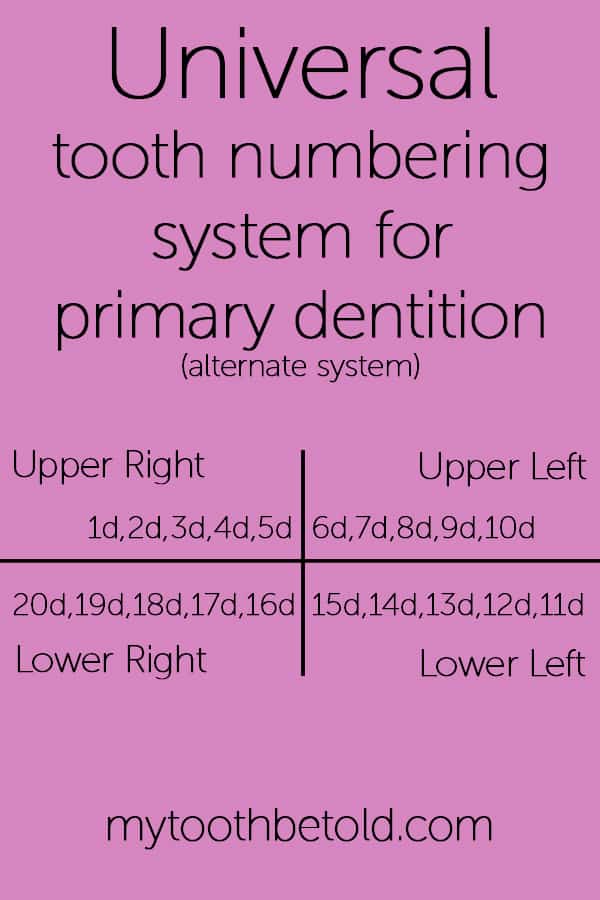
Read Now: Why Do Some People Not Have Wisdom Teeth?
Palmer
This system has since been revamped and modified into the FDI notation system. Even though it has been revamped, some countries are still using it and have not updated to the FDI system yet.
The palmer system uses a symbol resembling each quadrant and a number/letter for each tooth.
Quadrants and their respective symbols.
| Location in Mouth | Quadrant # |
| Upper Right | _| |
| Upper Left | |_ |
| Lower Left | |¯ |
| Lower Right | ¯| |
Adult/Permanent Teeth
| Tooth | Tooth # |
| Central Incisor | 1 |
| Lateral Incisor | 2 |
| Canine | 3 |
| 1st Premolar (1st bicuspid) | 4 |
| 2nd Premolar (2nd bicuspid) | 5 |
| 1st Molar (6-year molar) | 6 |
| 2nd Molar (12-year molar) | 7 |
| 3rd Molar (wisdom tooth) | 8 |
A permanent upper right central incisor would be;
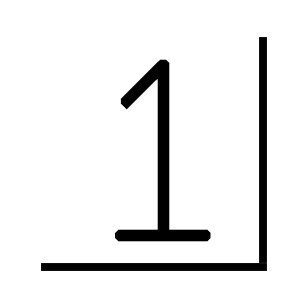
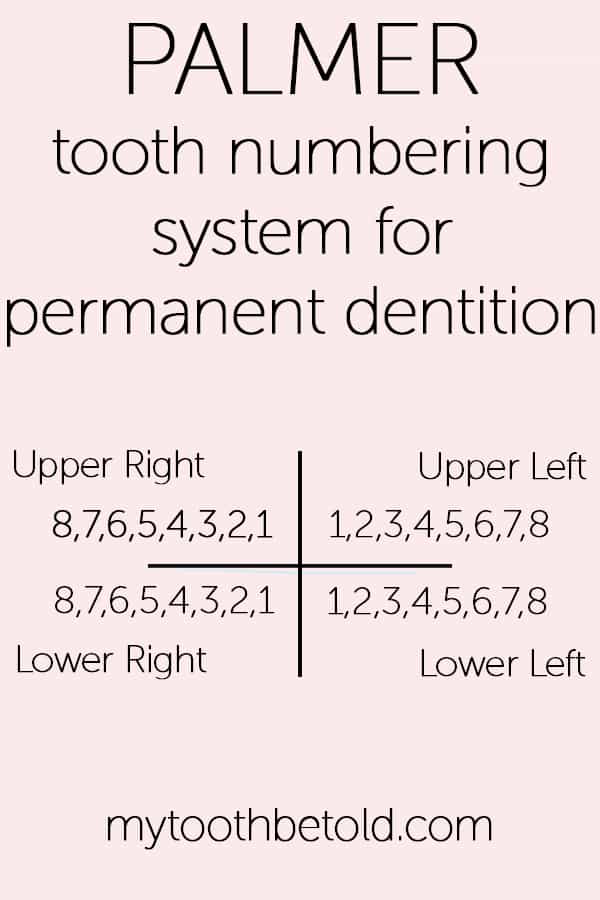
Baby/Primary (deciduous teeth)
| Tooth | Tooth Letter |
| Central Incisor | A |
| Lateral Incisor | B |
| Canine | C |
| 1st Molar | D |
| 2nd Molar | E |
A primary right central incisor would be:
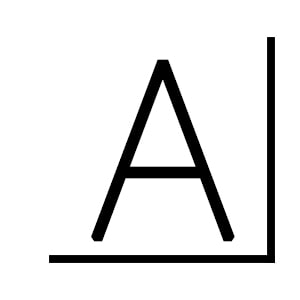
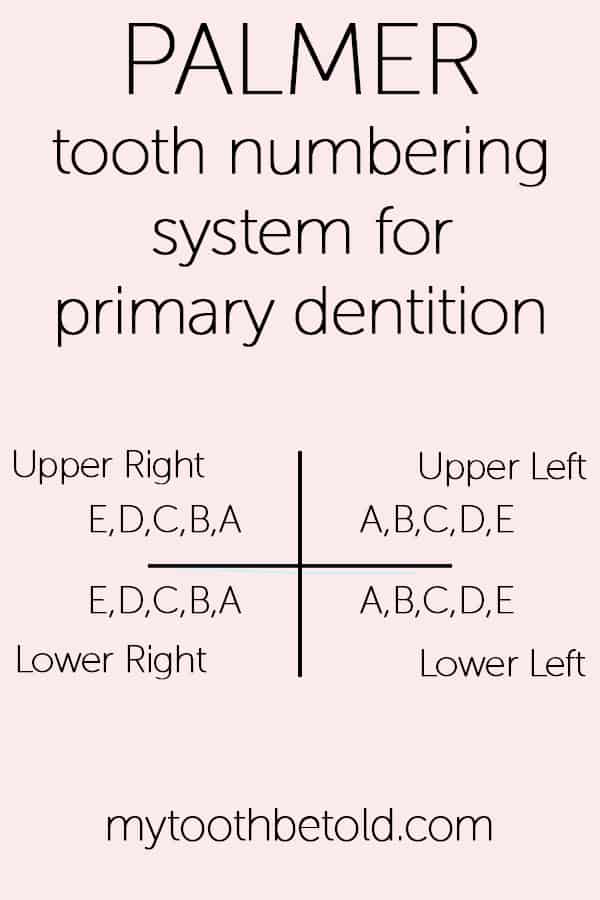
Zsigmondy (alternate system)
The only difference in the Zsigmondy notation system is that it uses Roman Numerals to indicate the primary teeth.
This was changed by Palmer because Roman Numerals could be confusing and mistakes were made when identifying the teeth.
Baby/Primary (deciduous teeth)
| Tooth | Tooth # |
| Central Incisor | Ⅰ |
| Lateral Incisor | Ⅱ |
| Canine | Ⅲ |
| 1st Molar | Ⅳ |
| 2nd Molar | Ⅴ |
The permanent teeth are the same as the Palmer dental notation.
Victor Haderup Notation (Danish alternate system)
With this variation, the “L-shaped” symbols are not used, and in place + and – symbols are used.
| Jaw | Symbol |
| Upper jaw (maxilla) | + |
| Lower jaw (mandible) | – |
Where the + and – symbols are located beside the tooth number/letter indicates either the right or left side of the mouth.
If the symbol is to the right of the tooth number/letter is means it is on the right side of the mouth and vice versa on the left side.
| Side (right or left) | Location of symbol |
| Right | Example: 1- or 1+ |
| Left | Example: -1 or +1 |
The permanent upper right central incisor would be: 1+
The permanent upper left central incisor would be: +1
Read Now: How Dental Hygienist’s Clean Your Teeth
Letter/Number system
This system uses the quadrants of the mouth. The quadrants are labelled as the following;
| Quadrant | Notation |
| Upper Right | UR |
| Upper Left | UL |
| Lower Left | LL |
| Lower Right | LR |
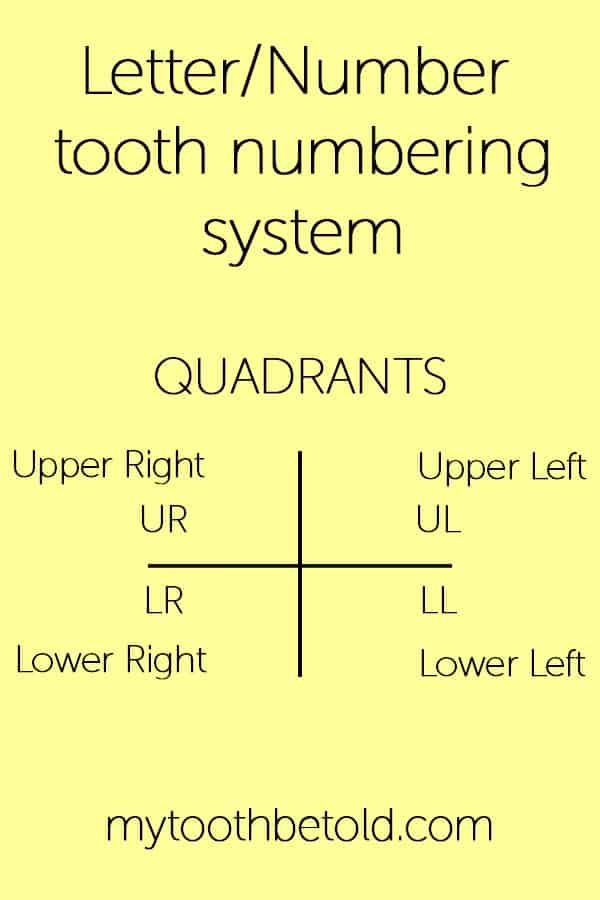
Adult/Permanent Teeth
Then the location of the tooth WITHIN that quadrant is numbered the same as the FDI system;
| Tooth | Tooth # |
| Central Incisor | 1 |
| Lateral Incisor | 2 |
| Canine | 3 |
| 1st Premolar (1st bicuspid) | 4 |
| 2nd Premolar (2nd bicuspid) | 5 |
| 1st Molar (6-year molar) | 6 |
| 2nd Molar (12-year molar) | 7 |
| 3rd Molar (wisdom tooth) | 8 |
So if we are referring to the permanent upper right central incisor it would be UR1.
Baby/Primary (deciduous teeth)
However, the baby teeth do not follow the FDI system, they have their own lettering system starting at the midline with the central incisors being A and the 2nd molars being E.
| Tooth | Tooth Letter |
| Central Incisor | A |
| Lateral Incisor | B |
| Canine | C |
| 1st Molar | D |
| 2nd Molar | E |
A primary upper right central incisor would be: URA.
The many languages of dental notation have confused me so many times I’ve lost count. Even in practice when referring to primary teeth I often have to count to make sure I’m saying the right tooth number. Practice makes perfect I guess, I’ll keep working at it!
Tooth Surfaces
If memorizing tooth numbers wasn’t enough, each tooth has 5 separate surfaces. Knowing the exact surface of the tooth helps us to indicate where a problem area could be. Is there an issue on the biting surface? Or on the tongue side of the tooth?
These surfaces are;
- Mesial
- Distal
- Buccal (labial)
- Lingual (palatal)
- Occlusal (incisal)
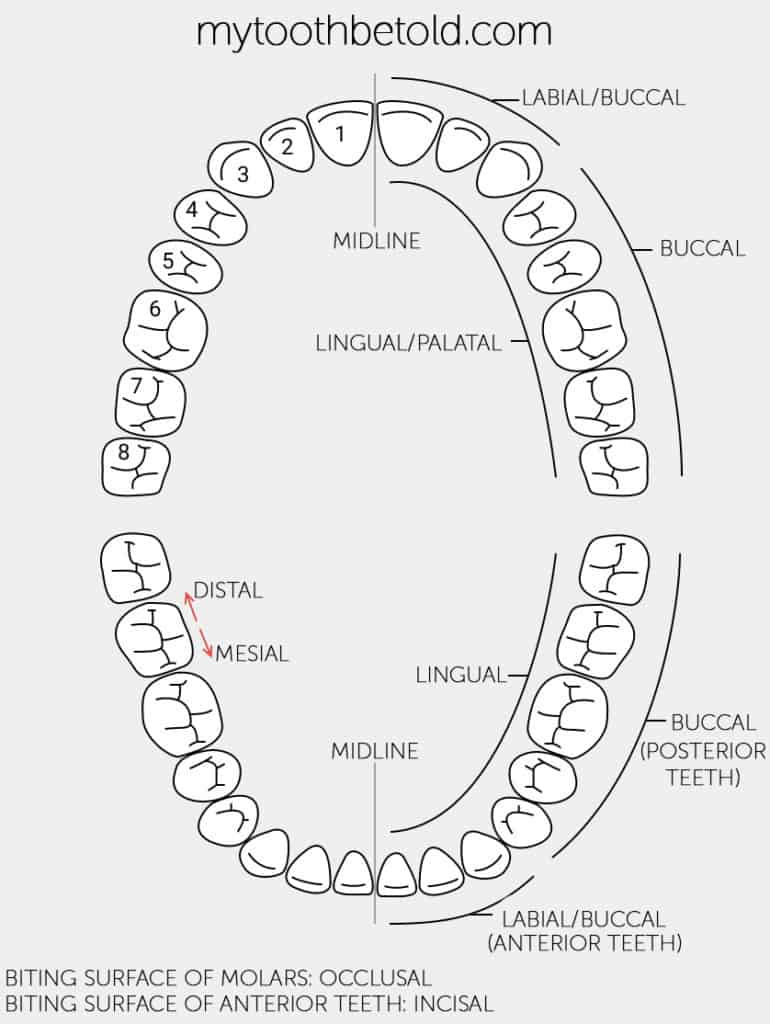
Mesial
The mesial surface of a tooth is the surface that is the closest to the midline of your face (the front of your face). This surface will be closest to the tooth in front of it.
Distal
The distal surface of a tooth is the surface that is the closest to the back of your mouth (towards your throat). This surface will be closest to the tooth behind it.
Buccal (labial)
The buccal surface of a tooth is the surface that touches the cheek/lip. Buccal is the term used for the cheek and labial is the term used for the lip.
The anterior teeth (canine to canine in each quadrant) the surface can be referred to as labial because it touches the lip.
Lingual (palatal)
The lingual surface refers to the surface next to your tongue on the “inside” of your mouth. It can be used for both the top and bottom teeth.
Palatal is a term used for the inside of the top teeth because they are next to your palate.
Occlusal (incisal)
The term occlusal refers to the biting surface of the tooth.
However, on the front teeth (canine to canine) the biting surface is referred to as the incisal.
—
Let’s say you have a cavity on your upper right permanent first molar on the biting surface. I would describe it as the 16O or 16 occlusal using the FDI notation system.
I hope I’ve helped you to understand the different dental notations that are used around the world.
Have a great day,
Holly 🙂
